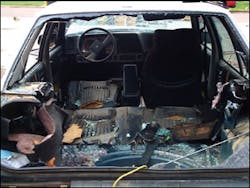SUBJECT: NFPA 1670 Vehicle Rescue, Technician-level Skills and Competencies
TOPIC: Advanced Hands-on Training Skill: Trunk Tunneling
OBJECTIVE: Given the scenario of a vehicle crushed beneath the trailer of an 18-wheeler tractor trailer truck with a simulated driver trapped, complete a trunk-tunneling evolution to access and extricate the patient.
TASK: Open a trunk without using a key and complete the trunk “tunneling” evolution, allowing a rescuer to enter the trunk and access the driver’s seat area of the vehicle
This University of Extrication column is the fourth installment of our multi-part series presenting advanced technician-level vehicle rescue training scenarios. This installment describes a rescue challenge that meets the criteria of a technician-level skill and competency of NFPA Standard 1670.
This scenario is based on an incident where a sedan vehicle is crushed beneath the trailer of a tractor-trailer truck with the vehicle’s driver trapped. The training simulation is that the crews are having difficulty accessing the patient, so the decision is made to breech the rear of the vehicle to gain access to the interior. In what is called trunk “tunneling,” all portions of the rear of the sedan are moved or removed to open up the entire rear area of the car. When completed, a patient would be able to be longboarded out the rear opening.
The vehicle selected for training should be sedan-style with a trunk and a rear window. Hatchbacks are acceptable, but not as challenging. Station wagons, minivans or pickup trucks are not as beneficial for this specific training scenario.
Trunk Tunneling
A four-person team should be capable of accomplishing this task in eight minutes or less. For training purposes, the goal is to enter the trunk area, access the interior of the vehicle and create an extrication pathway for a simulated patient trapped in the driver’s seat. To simulate the tractor-trailer truck, place a traffic cone beside each rear tire. Personnel must stay behind these cones at all times as they tunnel into the interior of the sedan. This forces the crew to focus on the trunk and rear window areas as their primary work areas.
The most effective strategy is to think about how the rear of the vehicle would open up if it were a hatchback. With the hatch open, there is nothing obstructing access to the interior of the vehicle. This is the same result that the new opening must accomplish, except that the vehicle is a sedan and it has a lot of items that initially prevent access to the interior from the rear trunk area. Crews must take the sedan-style vehicle and move or remove whatever necessary to gain access to the driver trapped inside.
After stabilization of the vehicle, the primary tunneling tactics include opening the trunk without using a key. Once this has been completed, it is best if the trunk lid is completely removed. Next, the rear-window glass must be removed, followed by the rear speaker-deck structure. With the trunk and deck open, the partition separating the trunk from the rear seat must be moved or removed.
Once the rear seat is moved, rescuers will be confronted with the rear of the driver’s seat. To access the simulated patient, there are two options. In a real-world situation, the back of the driver’s seat may be able to be reclined. This would allow a longboard to be positioned so the driver can be extricated.
To mimic a worst-case scenario, however, in this training evolution rescuers are required to either completely remove the driver’s seatback or just cut through the hinge on the right side of the driver’s seat back. Once the right seat hinge is cut, the seatback can be swiveled so the back of the seat is against the driver’s door. Moving the seatback typically provides enough room for the longboard to be positioned. To finish the task, all “sharps” should be protected.
In an actual incident, there may be a roof-opening option in addition to trunk tunneling. Depending upon how deep under the truck the car is positioned, a power spreader may be positioned at the center of the rear window opening. The tool can pry the center of the rear roofline upward while at the same time crush the rear speaker deck downward. This may give rescuers increased access to the interior of the vehicle.
TASK: Open a trunk without using a key and complete the trunk “tunneling” evolution allowing a rescuer to enter the trunk and access the driver’s seat area of the vehicle
Ron Moore, a Firehouse® contributing editor, is a battalion chief and the training officer for the McKinney, TX, Fire Department. He also authors a monthly online article in the Firehouse.com “MembersZone” and serves as the Forum Moderator for the extrication section of the Firehouse.com website. Moore can be contacted directly at [email protected].





